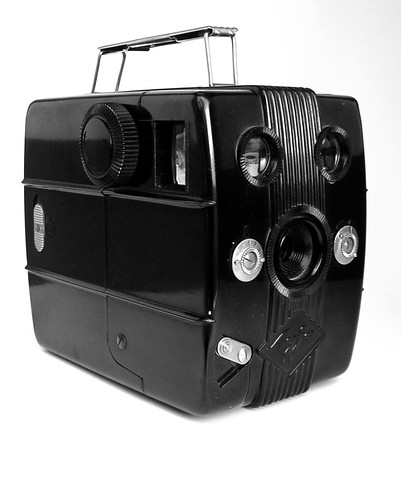Difference between revisions of "Agfa Trolix"
m (added image attrib) |
(re-arranged to avoid bullet overlappage; smoothed some punctuation & phrasing) |
||
| Line 2: | Line 2: | ||
||image_source= http://www.flickr.com/photos/jeronimogirona/2104660329/in/pool-camerawiki | ||image_source= http://www.flickr.com/photos/jeronimogirona/2104660329/in/pool-camerawiki | ||
|image= http://farm3.static.flickr.com/2186/2104660329_b0a394b70a.jpg | |image= http://farm3.static.flickr.com/2186/2104660329_b0a394b70a.jpg | ||
| − | |image_align= | + | |image_align= right |
|image_text= Agfa Trolix (1936) | |image_text= Agfa Trolix (1936) | ||
|image_by= jgs4309976 | |image_by= jgs4309976 | ||
|image_rights= wp | |image_rights= wp | ||
}} | }} | ||
| − | The '''Box 14''', better known under the name '''"Trolix"''', was manufactured by [[Agfa|Agfa Camera-Werk]] in Munich, Germany (1936 - 1940) and consists of the dark brown plastic Trolitan - similar to [[Bakelite]], | + | The '''Box 14''', better known under the name '''"Trolix"''', was manufactured by [[Agfa|Agfa Camera-Werk]] in Munich, Germany (1936 - 1940) and consists of the dark brown plastic Trolitan - similar to [[Bakelite]], in an Art Deco style. In the Netherlands, the camera was sold until 1942. With two adjustable wheels on the front one can choose between two apertures and the shutter can be set either to M (Moment) or Z (Zeit = Bulb). It uses [[120 film]] (Agfa B 2) for 6×9cm images. The camera has two brilliant viewfinders, a tripod thread and a [[red window|red film window]]. The carrying handle is made of chrome-plated metal. Since it's made from an early form of Bakelite it is extremely vulnerable: If dropped it will most likely shatter into pieces. |
| − | + | == Links == | |
| − | |||
* [http://de.wikipedia.org/wiki/Agfa_Box#Trolix-Box Trolix on Wikipedia] | * [http://de.wikipedia.org/wiki/Agfa_Box#Trolix-Box Trolix on Wikipedia] | ||
*[http://www.collection-appareils.fr/agfa/html/trolix.php Trolix] at [http://www.collection-appareils.fr/general/html/francais.php Sylvain Halgand's www.collection-appareils.fr] | *[http://www.collection-appareils.fr/agfa/html/trolix.php Trolix] at [http://www.collection-appareils.fr/general/html/francais.php Sylvain Halgand's www.collection-appareils.fr] | ||
Revision as of 18:03, 6 August 2011

|
| Agfa Trolix (1936) image by jgs4309976 (Image rights) |
The Box 14, better known under the name "Trolix", was manufactured by Agfa Camera-Werk in Munich, Germany (1936 - 1940) and consists of the dark brown plastic Trolitan - similar to Bakelite, in an Art Deco style. In the Netherlands, the camera was sold until 1942. With two adjustable wheels on the front one can choose between two apertures and the shutter can be set either to M (Moment) or Z (Zeit = Bulb). It uses 120 film (Agfa B 2) for 6×9cm images. The camera has two brilliant viewfinders, a tripod thread and a red film window. The carrying handle is made of chrome-plated metal. Since it's made from an early form of Bakelite it is extremely vulnerable: If dropped it will most likely shatter into pieces.